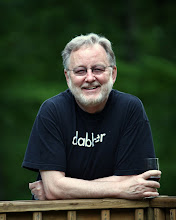Saturday, December 13, 2003
My Blog Reading List
Recently in a newsletter that I distribute periodically to a small circle of family and friends, I recommended a browser add-on called Smart Explorer because it provides you the ability to define "smart groups" of websites and allows you to open them simultaneously with one click. One of the smart groups I defined in my copy of Smart Explorer is called "blogs," and it consists of seven blogs that I check regularly to see what they are advocating or what they have found out since I last read them. These seven blogs illustrate some of the ways blogs differ from one another and a variety of ways that they can be maintained. Today I thought I'd introduce you to those blogs and point out some of the things that are unique about each of them.
In MIT Blog in Technology Review: MIT's Magazine of Innovation, several writers (Simon Garfinkel, David Kushner, and Henry Jenkins among others) contribute postings with the theme "Insights, commentary, and analysis about technology and its impact." Since I am interested in "technology and its impact," I find this site worth regular visits and because it is maintained by people associated with Massachusetts Institute of Technology I tend to believe that they know what they are talking about and that they may have some link to the latest developments in that field.
Another blog that is maintained by multiple authors is SATN.ORG. The three primary authors of this blog are Bob Frankston, David Reed and Dan Bricklin. Frankston and Bricklin are noteworthy because they are the authors of the very first spreadsheet program, VisiCalc, that gave rise to a genre of software I find essential in my daily work and one that is widely used in the business world. Each of these authors also maintain their own websites separately from their combined efforts at SATN.ORG. Frankston's is here, Reed's is here and Bricklin's will be discussed in the next paragraph because it is the next blog in my list. The advantage of blogs that are maintained by several authors is that the postings provide multiple perspectives and are likely to be more frequently updated. The demands of daily posting are a chore for a blog such as mine that is maintained by a single individual. Ironically, SATN.ORG deviates from this general rule that multiple authors increases the likelihood of daily postings, and often there are long stretches between postings on it. For instance, as of this morning the most recent posting at SATN.ORG was December 1, 2003. Nevertheless, I find the comments that appear there are thought-provoking and worth the wait.
Dan Bricklin's blog is one that I have followed for a long time. Bricklin uses a tool that he created to maintain his site. In its current incarnation, this tool is called CuteSITE Builder, and it was previously known as Trellix web. This link explains all that. He describes the purpose of his blog thusly, "This log covers my thoughts on making web sites, the computer industry, digital photography, PC history, conferences I attend, and people I know or run into." He maintains links to some interesting articles he has written through the years, many of which are well worth the time spent reading them.
Doc Searls Weblog is one of the most active weblogs that I've found on the web. He is a professional writer, a Linux advocate, and one of the most widely known and quoted weblog writers around. Along with several others (Christopher Locke, Rick Levine, and David Weinberger), he wrote The Cluetrain Manifesto in April, 1999, that has become a classic commentary about how businesses relate to their customers and how the Internet has had an effect on long-standing myths about that process.
I'm still reading Dan Gillmor's eJournal since he was one of the first weblog authors I discovered. Gillmor is a technology journalist for the San Jose Mercury News, and though I don't find his eJournal (blog) as interesting as I used to, I still occasionally find a link there that I think is worth investigating.
Metafilter is a very unique weblog. It consists of entries posted by the community at large. The topics are as diverse as the 17173 members of that community's individual interests or concerns. More than any other weblog I have visited, this one illustrates the conversational possibilities of a weblog. Members post an article and then other members engage in a conversation about it by clicking on the "comments" link where they post their comment about the posting. When a controversial or particularly interesting entry is posted, it isn't unusual for there to be over a hundred responses to the topic under discussion. This weblog is a constant source of the bizarre or unique things one can find on the web.
Jay Rosen's weblog, PressThink, is focused on journalism. Jay "is a press critic and writer whose primary focus is the media's role in a democracy. A member of the faculty since 1986, he is the current chair, and teaches courses in media criticism, cultural journalism, press ethics and the journalistic tradition, among other subjects." The articles he posts are well-written (what else?) and thoughtful. His site also frequently provokes a lot of discussion about each of his postings. One needs to don his thinking cap before reading this weblog though because it isn't casual reading. I find it quite stimulating to follow his commentary.
So there you have the "magnificent seven" blogs that I read with some regularity (three to five times a week). Try some of them out. I think you'll find that there are weblogs out there that aren't of the what-I-had-for-breakfast variety and that offer some information about what is going on in the world.


